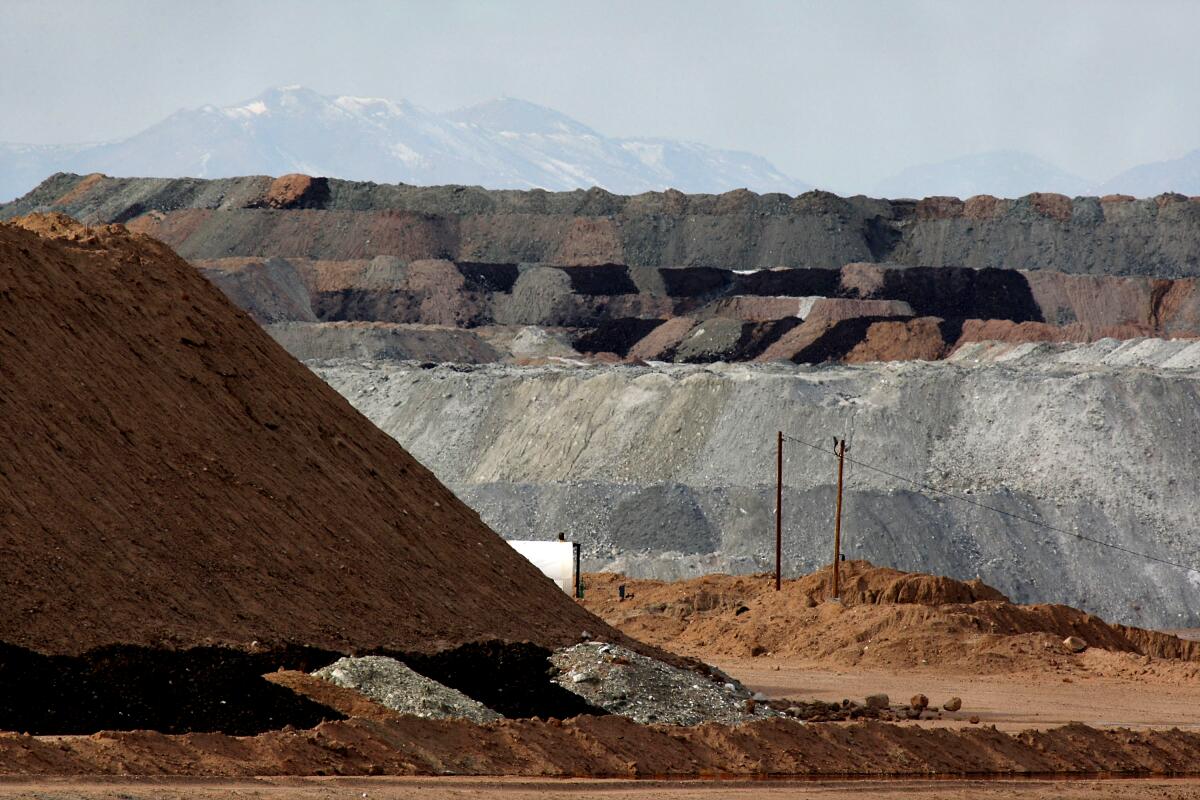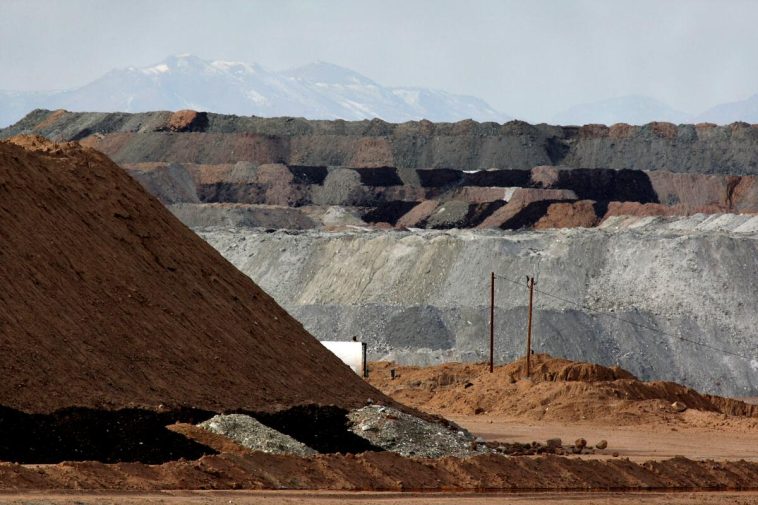
Rio Tinto’s Balancing Act: Copper, Lithium, and Iron Ore in a Shifting Global Market
As the global commodities landscape shifts with uneven demand and pricing pressures, Rio Tinto finds itself at a crossroads. In recent months, the mining giant has been strategically expanding its portfolio by pushing deeper into copper and lithium while grappling with persistent pressures on its flagship iron ore assets. This editorial takes a closer look at the company’s current performance, future potential, and the tricky parts of navigating an inherently volatile global market.
With decades of history under its belt and operations stretching across continents, Rio Tinto’s journey from a traditional resource extraction company to a diversified and technically advanced global player is both fascinating and full of twists and turns. As investors and industry watchers continue to weigh in on the group’s next steps, it is essential to examine how the company’s moves into battery-grade materials and alternative metals might shape its long-term outlook.
Historical Legacy and Evolving Strategies
Founded in 1873, Rio Tinto has steadily transformed from a conventional mining firm into a multifaceted enterprise. Dual-listed in London and Melbourne, the company operates across four core segments: Iron Ore; Aluminium (including bauxite and alumina); Copper & Diamonds; and Energy & Minerals. Over the decades, the firm’s ability to adapt to market shifts has underpinned its position among the most efficient producers in a cycle-driven industry.
Today, Rio Tinto’s revenue mix ranges from traditional commodities, like iron ore, that are critical to construction and steelmaking, to emerging markets such as lithium—a material whose demand is surging alongside the global transition to electric vehicles (EVs) and renewable energy storage solutions. As such, the company’s evolution is as much about embracing growth in new arenas as it is about sustaining its legacy operations.
Understanding the Revenue Mix and Market Dynamics
Rio Tinto reported revenues of $53.66 billion in 2024, driven primarily by large-scale operations in low-cost Pilbara iron ore mining. However, challenges remain. The cyclical nature of global demand for steel and construction materials, coupled with an 11% drop in iron ore prices, has stoked concerns among some investors. Meanwhile, slower Chinese steel production—down 9.2% year-on-year as of June 2025—has raised further questions about near-term demand.
Even as the company’s revenue dipped marginally, it managed to maintain a robust underlying EBITDA of $23.3 billion. This stability, despite volatile commodity prices, underlines a critical aspect of Rio Tinto’s business model: its ability to generate cash flow even during turbulent periods.
Key Factors Impacting Revenues
- Global Steel Demand: A decline in steel production, particularly in heavy industrial markets like China, puts downward pressure on iron ore prices.
- Commodity Price Fluctuations: Rapid shifts in market sentiment can lead to pronounced price swings for commodities, affecting revenues directly.
- Growth in Copper and Lithium: Positive developments in these segments could help offset declines in iron ore revenues, as demand picks up in EVs and renewable energy infrastructure.
For investors, the subtle details that underpin Rio Tinto’s revenue streams require a nuanced understanding. The company continues to weigh these factors while exploring cost efficiencies and new growth avenues to protect its margins during periods of price downturns.
Growth Prospects: Copper, Lithium, and Beyond
Looking forward, Rio Tinto’s strategic expansion into copper and lithium markets represents a significant move to counterbalance the challenges faced by its traditional iron ore segment. The logic is clear: as the automotive and renewable energy sectors grow, so too does the demand for these metals.
Recent performance indicators are promising. Second-quarter 2025 saw copper-equivalent production jump by 13% year-on-year, while bauxite output reached new quarterly records. Moreover, shipments from the Simandou high-grade iron ore project in Guinea are expected to begin around November 2025. This project alone could contribute an additional 0.5–1.0 million tonnes in output for the year.
Shifting Focus: From Iron Ore to Diversification
In March 2025, Rio Tinto’s acquisition of Arcadium Lithium—subsequently rebranded as Rio Tinto Lithium—signaled a bold entry into the burgeoning battery-grade lithium sector. This move represents an essential pivot toward materials that are set to benefit from long-term structural trends rather than transient cycles.
Below is a table summarizing the emerging projects and their potential contributions:
| Segment | Recent Achievement | Future Outlook |
|---|---|---|
| Copper | 13% YoY increase in Q2 production | Steady demand from renewable energy and electronics |
| Lithium | Acquisition of Arcadium Lithium | Capturing a larger share of battery-grade lithium market |
| Iron Ore | Significant presence in low-cost Pilbara operations | New shipments expected from Simandou project in 2025 |
| Aluminium | Robust alumina refinery network | Long-term stability in a mature industry |
This diversified approach is not without its challenges. Investors need to consider the slightly confusing bits of transitioning across markets that operate under different demand cycles and regulatory regimes. Yet, these moves also carry the potential for long-term stability and growth, particularly as green technology reshapes global demand for metals.
Efficient Capital Management: The Pillar of Resilience
Despite the headwinds in its primary revenue drivers, Rio Tinto has demonstrated an ability to convert EBITDA into substantial operating cash flow. In 2024, the company generated approximately $5.55 billion in free cash flow and efficiently turned $15.6 billion of underlying EBITDA into operating cash flow.
This impressive cash generation, combined with a net debt level of $5.49 billion (a modest 0.24× EBITDA), positions the firm well to manage its capital-intensive projects and fund future expansions. When you factor in a return on capital employed of 18% and a return on equity of nearly 20%, it’s clear that Rio Tinto continues to perform well financially despite the tricky parts of a cyclical business.
Capital Efficiency and Financial Strength
The company’s ability to work through periods of commodity price declines is bolstered by its strong capital management practices. Some of the key attributes include:
- Low Leverage: With a net debt to EBITDA ratio of only 0.24×, Rio Tinto is less exposed to the pressures of high financial leverage compared to some of its peers.
- Robust Free Cash Flow: Over $5 billion in free cash flow provides room for pursuing strategic investments and shareholder returns.
- Consistent Profitability: With returns on capital and equity in the high teens, the company demonstrates the ability to generate profits even when facing volatile market conditions.
For investors and market watchers, these characteristics are super important, serving as a strong foundation for the company’s continued growth and ability to finance new projects such as the Simandou shipments and lithium integrations.
Valuation in a Discounted Market
Rio Tinto’s current market valuation appears to be undervalued relative to historical averages and sector peers. Trading at a forward price-to-earnings ratio of 9.9× and a price-to-book multiple of 2.3×, the stock sits below its five-year medians. Meanwhile, its enterprise-value-to-EBITDA ratio of 6.1× falls under the typical 8–9× range for the materials sector.
This relative discount has led some analysts to suggest that the market might be understating the company’s diversified earnings base and its promising future in copper and lithium markets. Even in the midst of a challenging global environment, Rio Tinto’s compelling balance of diversification, cost leadership, and strong cash generation offers potential upside for patient investors.
Comparative Valuation Metrics
Below is a quick breakdown of key valuation multiples that can help offer context:
- Forward P/E Ratio: 9.9× – indicative of market optimism rooted in potential recovery.
- Price-to-Book Ratio: 2.3× – below historical averages, pointing to potential undervaluation.
- EV/EBITDA: 6.1× – lower than sector norms, suggesting that the stock is trading on a discount.
These figures, while promising, should be considered in the context of a highly cyclic and sometimes unpredictable commodities market. The careful investor will consider these metrics as part of a broader analysis that includes competitive positioning, operational execution, and overall market sentiment.
The Bulls and the Bears: Divergent Perspectives on Cyclical Challenges
The market sentiment surrounding Rio Tinto is mixed. Roughly 35% of analysts rate the stock as a Buy, while about 60% lean toward a Hold recommendation. This divide is primarily driven by near-term concerns over commodity price declines and the cyclical nature of demand in markets such as iron ore.
On one side, bullish investors highlight the company’s low-cost operations and diversification efforts. They point to:
- Strong cash flow generation that supports a robust dividend yield of 5.8%.
- Strategic moves into growth metals, particularly copper and lithium, which are benefiting from global shifts in energy and automotive sectors.
- Potential upside from upcoming shipments and projects like Simandou, which could add significant volume once operational.
Conversely, bearish voices remain cautious. They cite:
- The ongoing volatility in commodity prices, especially a weak iron ore market exacerbated by sluggish demand in key regions such as China.
- Risks associated with large-scale projects, including potential delays and cost overruns that can chip away at projected returns.
- The unpredictable nature of market cycles that often lead to wild swings in earnings and dividend payouts.
Such divergent views underscore a critical point: while Rio Tinto holds long-term promise, the near-term environment remains challenging and loaded with potential pitfalls. Investors need to carefully figure a path through these mixed signals to decide on the right timing to increase exposure.
Key Risks and the Road Ahead
As with many global enterprises operating at scale, Rio Tinto faces a range of risks that could affect its future performance. Many of these are inherent in commodity markets, while others relate to operational and regulatory challenges.
Commodity Price Fluctuations and Global Demand Issues
One of the most obvious challenges lies in the unpredictable nature of commodity prices. Iron ore, for example, is expected to see average prices decline from roughly $97/t in 2025 to around $80/t by 2029. This trend, driven by potential oversupply and softer steel demand, could sharply compress both revenues and margins.
Similarly, the slowdown in Chinese steel production—already noted at a 9.2% year-on-year drop—adds another layer of concern. If Chinese property and infrastructure spending continue to falter, the demand for iron ore could remain subdued for longer than expected.
Execution Risks and Operational Disruptions
Large-scale projects such as the Simandou shipment and new lithium ventures carry considerable risks. These projects are measured in millions of tonnes and billions of dollars, meaning any operational hitches or delays could have a far-reaching impact on overall performance.
Weather-related issues in the Pilbara region serve as a cautionary example. Even short-term disruptions—like cyclones or port maintenance—can lead to sequential dips in shipments, as observed in Q2 2025 with a 1% reduction in iron ore shipments. While Rio Tinto has a track record of managing such disturbances, the possibility of execution missteps remains a worrisome factor for investors.
Regulatory and ESG Pressures
In today’s environmentally sensitive world, regulatory and ESG (environmental, social, and governance) pressures are on the rise. The company must balance growth with increasingly strict environmental regulations and community pressures which, at times, can become off-putting obstacles. Factors include:
- Environmental compliance costs and potential carbon-pricing implications.
- Community disputes and protests in regions such as Serbia, which could delay or hinder project approvals.
- The long-term sustainability of operations amid a global push for cleaner energy and reduced emissions.
Such challenges, while not unique to Rio Tinto, add layers of complexity to capital-intensive projects and strategic diversification efforts. They are among the many little twists that industry watchers must consider when evaluating the company’s long-term prospects.
Opportunities in a Transitioning Industry
Despite these headwinds, there is an optimistic narrative for Rio Tinto, primarily anchored in its ability to leverage scale and cost leadership. The company’s integrated operations, including its renowned Pilbara iron ore mines and extensive alumina refineries, provide it with a distinct competitive advantage during market downturns.
Moreover, Rio Tinto’s strategic expansion into copper and lithium not only diversifies its production base but also positions it squarely within two of the most dynamic segments of today’s energy and automotive revolutions. When markets eventually stabilize, these assets could propel the company into a new era of profitability and market relevance.
Benefits of Diversification into Growth Metals
Diving into the details, here are the key benefits Rio Tinto may reap by expanding its presence in growth metals:
- Copper: A crucial component in renewable energy infrastructure, electronics, and electric vehicles, copper production is witnessing rising demand around the world.
- Lithium: As a core material for batteries, lithium is positioned at the center of the electric vehicle boom. The acquisition of Arcadium Lithium could be a game-changer in this sector.
- Aluminium: Although more mature, aluminium remains essential for lightweight construction and transportation, preserving its relevance in an evolving market.
These growth areas not only diversify Rio Tinto’s income streams but also provide a buffer against the volatility of cyclical commodities. For investors with a long-term horizon, such moves are seen as critical steps toward future-proofing the company’s operations.
Investor Considerations and Strategic Timing
For those looking to take a position in Rio Tinto, the key is to appreciate the full picture—balancing immediate concerns with the longer-term strategic vision. The company’s current valuation, marked by metrics such as a forward P/E ratio of 9.9× and an EV/EBITDA of 6.1×, suggests that the stock is trading on a discount. This may well change if commodity prices stabilize or the potential of its new assets becomes fully realized.
Potential investors should consider the following points:
- Income Generation: With a dividend yield of 5.8%, Rio Tinto offers a reliable income source, which is particularly attractive in times of market instability.
- Growth Prospects: The strategic diversification into copper and lithium represents key moves toward capturing future market trends, albeit with their own set of challenges.
- Market Cyclicality: Understanding that commodity prices are inherently volatile is essential. The stock may experience sharp fluctuations, reflecting broader economic shifts.
- Project Execution Risks: Large projects like Simandou require careful monitoring. Any delays or budget overruns could impact the company’s forecasted performance.
Ultimately, investors must weigh the balanced package of attractive dividend yields, strong cash flow, and diversification against the potential for near-term disruptions. Those willing to weather the initial volatility might find Rio Tinto a compelling stock, with its combination of low-cost production and strategic growth projects offering a potentially rich payoff over time.
Upcoming Milestones and Their Implications
Looking ahead, several key events are on the horizon that may influence investor sentiment and market performance. Close attention to these events will be critical in assessing the momentum behind Rio Tinto’s forward trajectory.
Critical Upcoming Events
Below is a list of some events that could be super important for those monitoring the company’s progress:
- Q2 2025 Earnings Release: The second-quarter results and the subsequent conference call are scheduled for July 30, 2025. These will provide insights into production volumes, commodity realizations, and the progress of ongoing projects.
- CEO Transition: With Simon Trott set to take the helm on August 25, 2025, a potential reshaping of operational priorities and cost control measures is on the agenda. A leadership transition always warrants a closer look at strategic shifts.
- First Simandou Shipments: Expected to begin around November 2025, this milestone could open up an entirely new revenue stream in high-grade iron ore, signifying the commencement of a key project’s operational phase.
- Q3 2025 Production Results: Set for release in mid-October 2025, these results will be pivotal in assessing the full-year guidance and the recovery trajectory following earlier weather-related disruptions.
The outcomes of these milestones will shape perceptions of Rio Tinto’s execution capabilities and strategic direction in the near future. Investors and market watchers alike will do well to monitor these events closely, as they are likely to have a substantial bearing on the company’s stock performance and broader market sentiment.
Balancing Innovation With Caution
Rio Tinto’s attempts to diversify its operations into growth industries like copper and lithium represent a cautious yet innovative strategy. These moves provide a safeguard against the cyclical downturns common in iron ore markets, yet they come with their own challenges that cannot be overlooked.
For many in the investing community, the company’s integrated operations and resilient cash flows offer reassurance. However, the mixing of traditional resource extraction with modern, green-energy aligned projects introduces a set of operational hurdles that require meticulous oversight. The potential for cost overruns and project delays looms large, particularly when economies are on edge and policy environments can change swiftly.
Nonetheless, for those able to steer through these headwinds, Rio Tinto’s underlying fundamentals—such as low-cost production, strong balance sheet metrics, and significant free cash flow generation—provide a robust foundation upon which future growth might be built.
A Snapshot of the Pros and Cons
To provide a clearer picture, consider the following bullet list summarizing the main strengths and challenges:
- Strengths:
- Integrated low-cost operations, particularly in the Pilbara region.
- Diversification into high-growth areas such as copper and lithium.
- Solid free cash flow generation and a strong balance sheet with low leverage.
- Attractive valuation metrics relative to sector peers.
- A compelling dividend yield that appeals to income-focused investors.
- Challenges:
- Vulnerability to commodity price swings, particularly in iron ore.
- Potential execution risks in large-scale growth projects including Simandou and green-field lithium ventures.
- Regulatory and ESG pressures that could delay or increase the cost of operations.
- High cyclicality resulting in potentially volatile earnings and share-price performance.
This balanced view is essential when weighing the risks against the rewards. While the opportunities appear promising over the long haul, the coming months will likely test the company’s ability to manage short-term volatility and execution challenges.
Final Thoughts: A Roadmap for Long-Term Investors
Rio Tinto stands at an interesting juncture. With a storied history as one of the world’s leading mining companies, it is actively working to redefine itself for the future. By integrating traditional mining operations with cutting-edge ventures in copper and lithium, the company is taking ambitious steps that could well pay dividends—both literally and figuratively—in the long run.
For long-term investors, Rio Tinto’s blend of strong cash flows, attractive dividend yields, and a diversified portfolio provides a sound basis for confidence. However, those looking to ride the wave of this transition must remain mindful of the near-term challenges. The volatile nature of commodity prices, coupled with potential delays in major projects, means that while the company’s fundamentals are robust, caution remains the order of the day.
Ultimately, Rio Tinto’s story is one of resilience and adaptation—a company that has weathered many economic storms and continues to find ways to generate value for its shareholders. Its strategic emphasis on growth metals offers the promise of capturing new market opportunities even as it remains anchored by its legacy in low-cost, high-efficiency production.
Navigating the Current Climate
For individuals watching the market, the operational strategies and capital management in place at Rio Tinto serve as a blueprint of how established companies can make a deliberate transition toward future-facing assets. While the short-term environment may be nerve-racking given the market volatility and execution risks, the stock’s attractive valuations and strong cash generation invite a closer look.
In a market that remains unpredictable, the case for leveraging diversification and steady free cash flow becomes all the more convincing. As the economic cycles ebb and flow, companies like Rio Tinto that manage to keep a balanced sheet and maintain operational discipline are likely to be the winners over the long haul.
Conclusion: Weighing Opportunity Against Volatility
The journey forward for Rio Tinto encapsulates much of what is happening in the broader industrial and commodities markets today. On one hand, you have a company with deep historical roots and an unmatched ability to generate cash in even the most challenging market conditions. On the other, its push into copper and lithium, driven by global transitions in energy and transportation, represents a bet on the future that is as ambitious as it is necessary.
In evaluating Rio Tinto, investors must make their way through a market environment loaded with both promise and pitfalls. The delicate balance between maintaining legacy operations in iron ore and capturing new growth in metals essential for modern technology underscores the company’s dual challenge: staying true to its cost-efficient roots while embracing the opportunities of tomorrow.
The current market discount, as reflected in Rio Tinto’s valuation metrics, may well be a reflection of the immediate challenges in the iron ore segment. However, in the light of its long-term strategic diversification and strong operational fundamentals, there is a persuasive argument that the stock is positioned for a turnaround once commodity cycles normalize.
For the prudent investor with a taste for steady, income-generating assets and a willingness to tolerate short-term price swings, Rio Tinto represents a practical opportunity. It is a story of evolution, resilience, and calculated risk—where the potential rewards may ultimately far outweigh the temporary setbacks.
As the next milestones unfold—ranging from upcoming earnings releases to project kick-offs and leadership shifts—those in the market would do well to keep a close eye on how Rio Tinto adapts to the tricky parts of a rapidly evolving industry. Whether you are a long-term investor banking on eventual recovery or a cautious observer waiting for firmer signs of market stabilization, the company’s journey is one that serves as a microcosm of the dynamism inherent in the global commodities sector.
In summary, Rio Tinto’s blend of strong fundamentals, strategic diversification, and disciplined capital management offers a compelling narrative amid market volatility. While near-term uncertainties persist, the company’s efforts to tap into new growth markets while optimizing its legacy operations provide a robust framework for long-term success. Only time will tell how these initiatives will translate into shareholder value, but for now, Rio Tinto remains a noteworthy player navigating a challenging yet opportunity-rich environment.
Originally Post From https://finimize.com/content/rtntf-asset-snapshot
Read more about this topic at
Economic Diversification In Mining-Dependent Regions
Net Zero Standard for Diversified Mining


